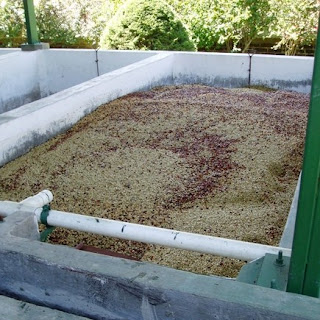WET PROCESS COFFEE BEANS
The wet process coffee beans are the big cost method because it requires a lot of water. The comparison approximately 1 kilogram of coffee cherries should be washed with about 1 to 6 liters of clean water. Therefore, the method is carried out by the large-scale coffee factory. The factory which has washing-station - where coffee cherries processed by the wet process method - in which the coffee cherries are washed, peeled, then fermented.
The factory which has washing-station - where coffee cherries processed by the wet process method - in which the coffee cherries are washed, peeled, then fermented. The wet process coffee beans method often used to process the arabica coffee beans. The reason is because this type of coffee valued high enough than robusta coffee. So that the processing cost spent is worth the price that will be received.
WET PROCESS COFFEE BEANS
SORTING COFFEE CHERRIES
In the wet process coffee beans method, first, selecting the coffee cherries which have been picked, to separate the ripe fruit, and immature. After that, the fruit was brought to a washing station for further processing. Coffee fruit entered into the flow of water channel that have been provided. At this stage, there has been a sorting process in which the floating fruit will go to different places and the sink one into the main venue.
PEELING RIND
Coffee fruit peeled by a peeling machine (pulper) using enough water. There are two types of spindles, which rotated manually and powered up. During peeling, circulate water continuously into the peeling machine.Water flow function is to soften the skin tissue pieces to be easily separated from the seeds.the process result of stripping the fruit skin is coffee beans that still have bark horns.
FERMENTED BEANS
The next process is fermentation where the coffee beans are still wrapped with the parchment skin allowed to stand in the tank (fermentation tank) for 12-36 hours or even more depend on the factory habit. This tank later covered with a tarpaulin. The fermentation process function to develop aroma, acidity, and flavor of the coffees. After fermentation, the coffee beans that still have the parchment skin are rinsed and dried in the drying floor for 3-11 days until the humidity around 11% -12%.
DRYING COFFEE BEANS
Because drying is dependent on the weather, so when the weather is bad, usually factory using a machine dryer (mechanical drying machine) that is capable of drying the parchment skin. By using the dryer, the drying process usually takes about 40 hours.
STRIPPING PARCHMENT SKIN
As with the other two processes, the coffee in the wet process also implementing resting in order to get a similar taste at the end of the process and when the coffee is brewed. the parchment dry skin that had rested was then peeled at peeler machine (huller).
FINAL SORTINGS COFFEE BEANS
Thereafter, directly sorted the coffee beans size using a machine similar to a giant strainer. Then, the next sorting process is sorting by hand to separate the coffee beans are indicated defects. The final grading process is also done so that the quality of the coffee beans can be classifiable.
If all of the above wet process coffee beans method has been completed, then the coffee ready to be packed into burlap sacks and sold to roasters. This wet process coffee beans method will make the coffee tasted more acidity and lighter body, but the taste that produced more diverse or complex. A large number of countries that producing coffee such as in Latin America or Central America, etc more implementing the process through this method. Meanwhile, in Indonesia, the wet process coffee beans method is often applied to Arabica coffee producing areas in Java, Bali, and part of Sulawesi.




